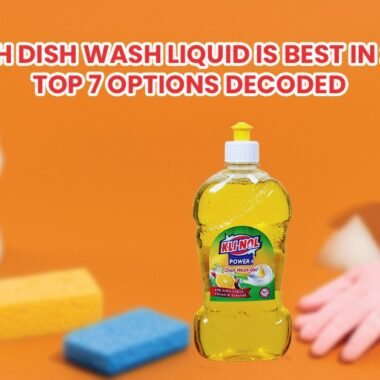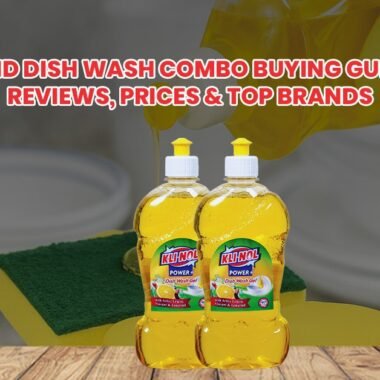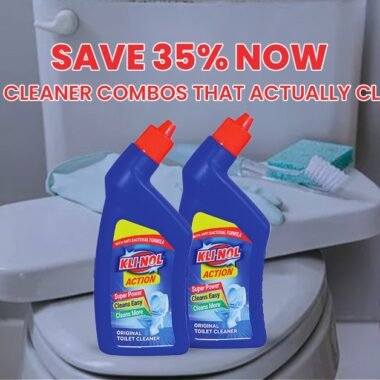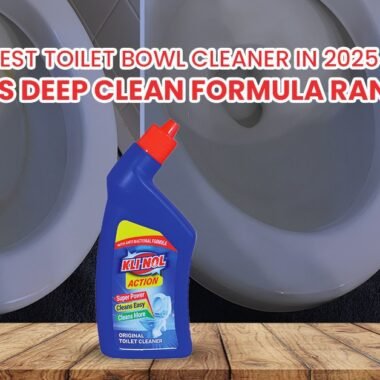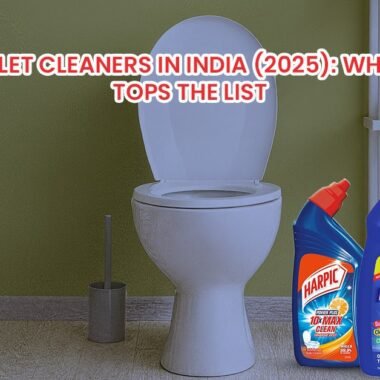Confused about the difference between bathroom cleaner vs toilet cleaner? ? Using the wrong one can ruin surfaces or miss germs.. This guide clears the confusion by explaining when to use toilet bowl cleaners versus multi-purpose bathroom products, based on their ingredients and purpose.
You’ll learn how acidic and alkaline formulas affect different surfaces, and whether toilet cleaner is safe for tiles. With clear examples and practical tips, you’ll pick the right product every time.
The global surface cleaner market is set to hit $60.2B by 2030 (Allied Market Research, 2024), showing rising demand for smart, specialized cleaning. Discover trusted, purpose-driven solutions at Klinol India—your expert source for bathroom and toilet cleaning products.
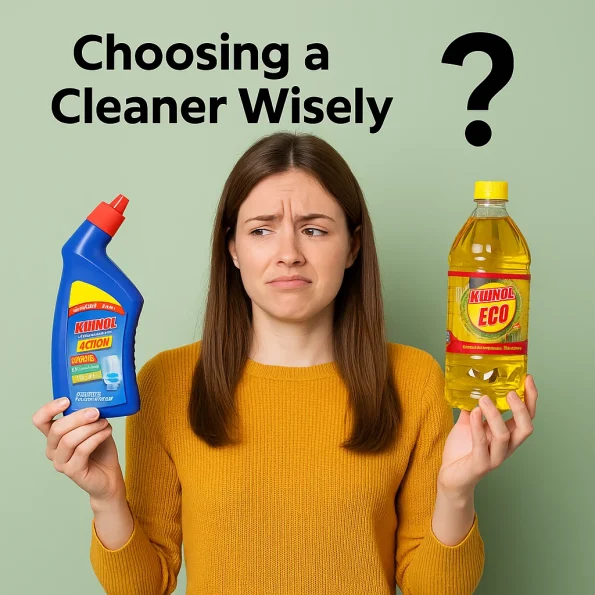
choosing cleaner wisely
Bathroom vs Toilet Cleaners: pH, Surfaces, Safety & Real-Use Tips
pH Levels:
- A typical toilet cleaning product maintains acidic properties, which target the removal of mineral residue and stubborn water stains.
- The pH levels of bathroom cleaners fall within a neutral range as well as slight alkalinity, which makes them appropriate for cleaning sinks and showers and tiles.
Ingredients:
- Due to their high concentrations of hydrochloric acid and bleach components, toilet cleaners succeed at cleaning both stains and odours and built-up material in the toilet bowl.
- All-purpose surfactants and disinfectants, along with milder chemicals present in bathroom cleaners, enable their use on multiple bathroom surfaces.
Surfaces:
- The sanitary formulation of toilet cleaners prepares them for exclusive applications within the toilet bowl container.
- Bathroom cleaners serve multiple surfaces because they effectively clean sinks together with tiles and mirrors, and counter surfaces.
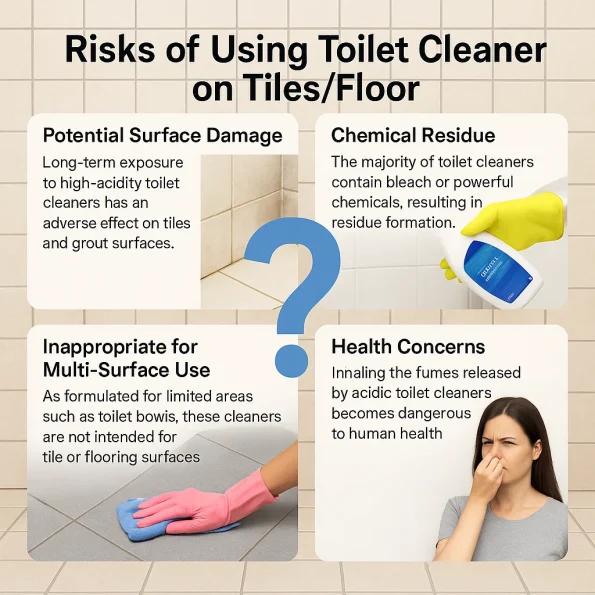
Risks of Using Toilet Cleaner on Tiles/Floor
Potential Surface Damage:
Long-term exposure to high-acidity toilet cleaners has an adverse effect on tiles and grout surfaces. Over time, the combination of such harsh chemicals will create discolouration and surface degradation.
Chemical Residue:
The majority of toilet cleaners contain bleach or powerful chemicals, which result in residue formation. Such residues cause health risks when remaining on tiles or floors unless the affected areas receive thorough rinsing.
Inappropriate for Multi-Surface Use:
As formulated for limited areas such as toilet bowls, these cleaners are not intended to perform general tasks on tile or flooring surfaces. Toilet cleaners should be used only in toilet bowls due to their specific formulation, which can produce unfavourable outcomes when used elsewhere.
Health Concerns:
Inhaling the fumes released by acidic toilet cleaners becomes dangerous to human health during bathroom floor and tile cleaning unless adequate ventilation exists.
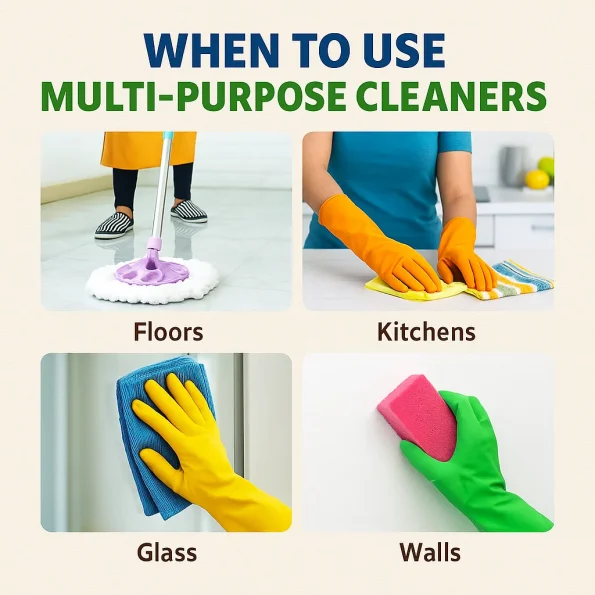
When to Use Multi-Purpose Cleaners
When to Use Multi-Purpose Cleaners
Everyday Cleaning:
People use multi-surface bathroom cleaners every day for basic cleaning duties. These products offer a cleaning function for many bathroom surfaces, including countertops and sinks, and tiles for quick bathroom maintenance needs.
Low-Maintenance Areas:
When no heavy soil or grime exists in a room, the multi-purpose cleaner represents an optimal solution. These cleaners serve the purpose of cleaning slightly dirty surfaces and enable users to replace specialised cleaning products.
Surface Versatility:
Multi-purpose cleaners contain ingredients that effectively clean glass and ceramics and plastic alike. These bathroom solutions do not harm bathroom surfaces when applied to mirror frames, bathroom counters, and tubs.
Cost-Effective:
The versatility of multi-surface bathroom cleaners makes them a suitable replacement for different types of cleaning products. Using these cleaners will prevent long-term financial loss by decreasing the number of required items.
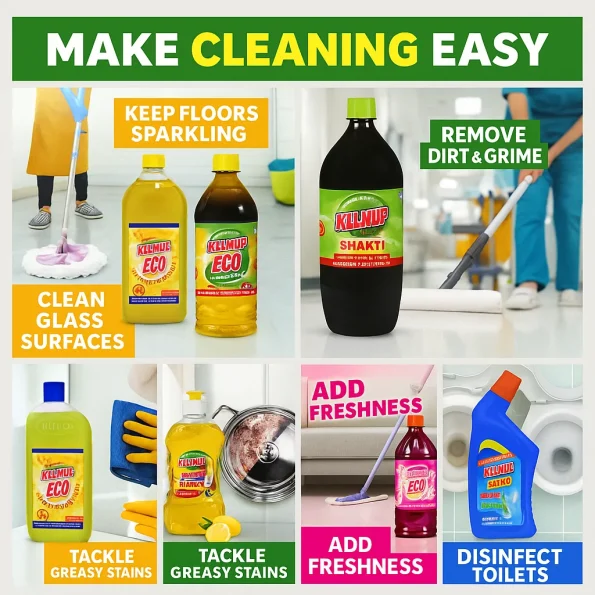
multipurpose klinol
Expert Recommendation: Klinol’s Specialised Range
Specialised Toilet Bowl Cleaner
The acidic components in Klinol’s toilet cleaner were specifically developed to perform toilet bowl sanitation effectively. The product removes all types of stains and odours and also prevents damage to ceramic surfaces.
Multi-Surface Bathroom Cleaner
The bathroom cleaner from Klinol functions on multiple surfaces because it cleans both sinks and tiles, and mirrors. The product maintains a gentle cleaning method that protects delicate materials from harm during the sanitisation process.
Reliable for Frequent Use
The products have been dermatologically approved for everyday use due to their specific formulations. The products show concern for environmental protection, which enables consumers to choose them with confidence about sustainability.
Trusted by Professionals
Through proper product segmentation, Klinol enables specialised cleaning, which lowers the odds of incorrect procedures. Professionals trust this solution because of its dependable performance, which has earned them the position as the cleaning experts’ preferred choice.
DIY Hack for Stubborn Stains
1. Baking Soda and Vinegar Combo:
A mixture of baking soda along with water should be applied to stains on tile surfaces and grout areas. The combination produces a foaming reaction when vinegar contacts the pasted baking soda, which naturally removes stains.
2. Lemon Juice and Salt:
Lemon juice blended with salt creates a paste that gently removes stains from bathroom fixtures, along with fading all water marks and rust damage. The mixture successfully removes spots from taps along with other metal components.
3. Hydrogen Peroxide Solution:
Deep tile cleaning requires a solution made from a diluted hydrogen peroxide mixture. Correct application of the solution produces disinfection and surface brightening results that protect surfaces from degradation.
4. Toothpaste for Light Marks:
People can brush off surface stains from bathroom tiles by using conventional white toothpaste, followed by a soft brush. The combination of gentle brushwork and no damage to the tile surface is achievable with a soft brush.
5. Borax for Mould and Mildew:
Using borax as a spray on mould-prone areas, followed by a brief examination time before cleaning it away, will effectively eliminate mould and mildew growth. The substance finds effective use when cleaning the corners of bathrooms alongside grouting.
Conclusion
Choosing the right product in the debate of bathroom cleaner vs toilet cleaner isn’t just about cleanliness—it’s about protecting your surfaces, health, and wallet. Using the wrong cleaner can cause costly damage or leave behind harmful residues.
With Klinol India’s specialised range, you never have to guess. Our toilet bowl cleaner is tough on stains but gentle on ceramics, while our multi-surface bathroom cleaner is perfect for daily use on sinks, tiles, and mirrors.
Make smart, surface-safe choices today—visit KlinolIndia.com and bring expert-level cleaning into your home.
FAQ’s
What’s the difference between bathroom cleaner vs toilet cleaner?
Klinol toilet cleaner targets toilet bowl germs and stains, while the bathroom cleaner is safe for multi-surface use.
Can Klinol toilet cleaner be used on tiles?
No, it’s a specialised toilet bowl cleaner and not suitable for tiles or multi-surface cleaning.
What is the difference between bathroom & toilet cleaners in terms of formulation?
Toilet cleaners like Klinol are acidic, while Klinol’s multi-surface bathroom cleaner is mildly alkaline and gentle.
Why choose a multi-surface bathroom cleaner like Klinol?
It’s safe on taps, tiles, and sinks, ideal for everyday cleaning without harsh effects.
Are acidic vs alkaline cleaners different?
Yes acidic cleaners like Klinol toilet cleaner remove limescale, while alkaline ones lift grease and soap scum.


